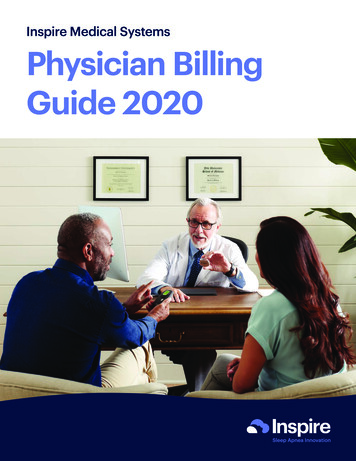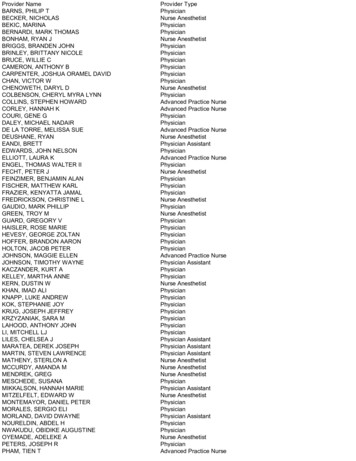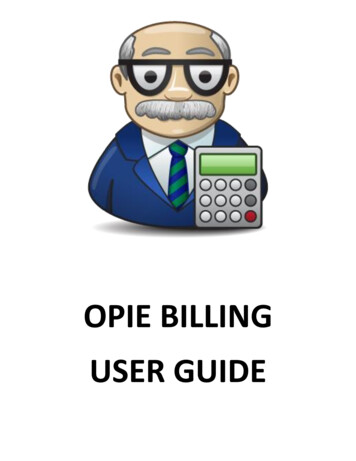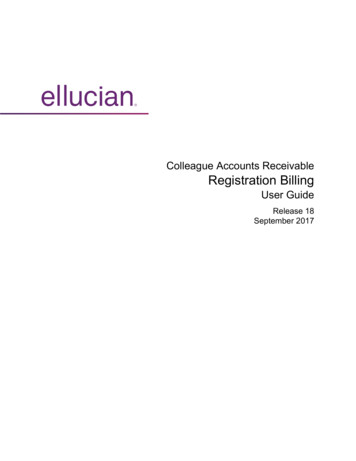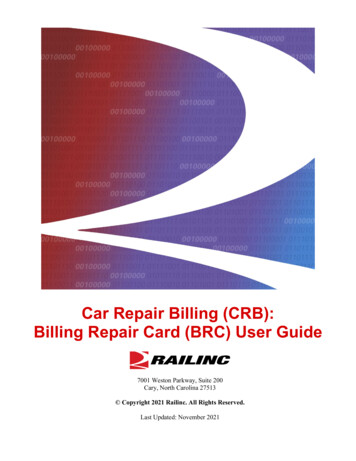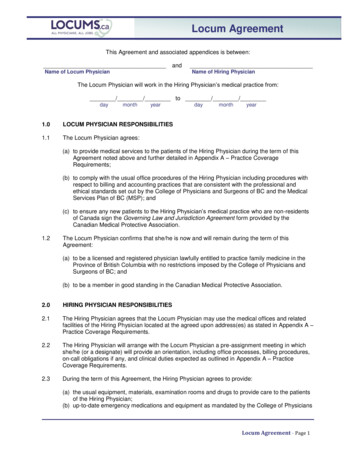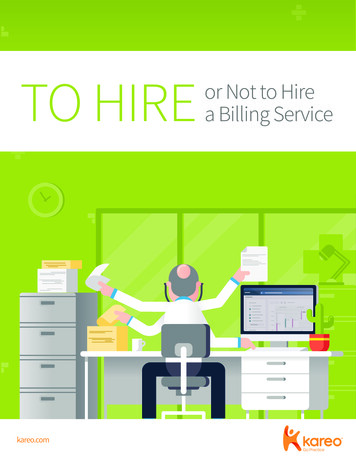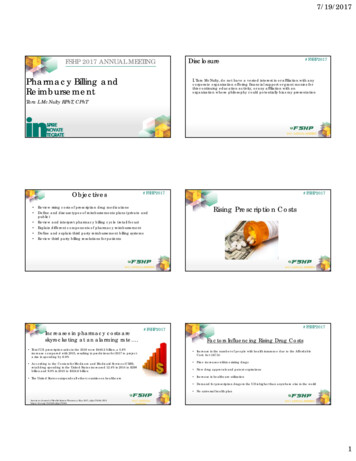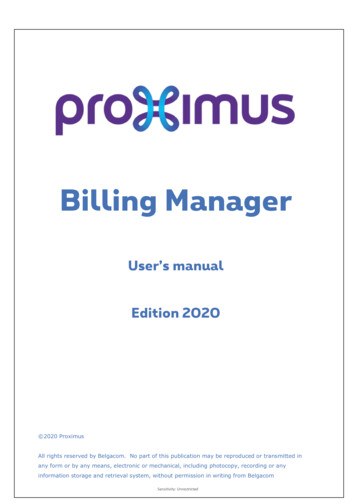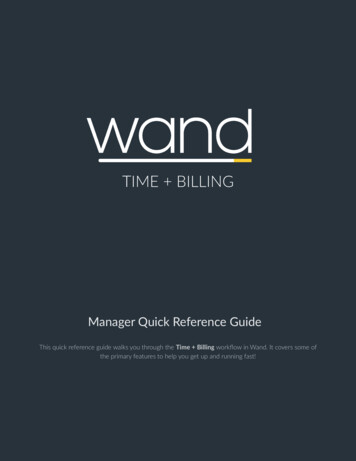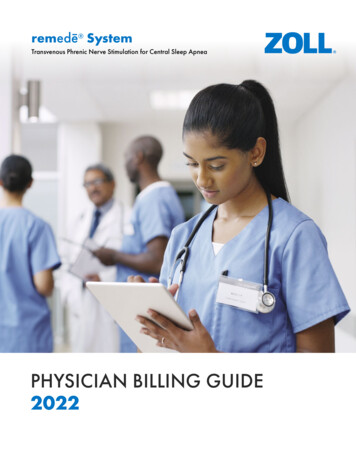
Transcription
remedē SystemTransvenous Phrenic Nerve Stimulation for Central Sleep ApneaPHYSICIAN BILLING GUIDE2022
The remedē System Physician Billing GuideThis guide contains physician and hospital coding and reimbursement information for procedures associated with the remedēSystem to treat moderate to severe central sleep apnea. For more information on hospital billing, the 2022 remedē System HospitalBilling Guide is available online at remede.zoll.com/reimbursement or by contacting the remedē Reimbursement Hotline.Disclaimer: The information provided in this guide is general reimbursement information only; it is not legal advice, nor is it adviceabout how to code, complete or submit any claim for payment, nor is it intended to increase or maximize reimbursement by anythird-party payer. All coding and reimbursement information is subject to change without notice. The content provided by the Centerfor Medicare and Medicaid Services is updated frequently. It is the responsibility of the health services provider to confirm theappropriate coding required by their local Medicare carriers, fiscal intermediaries, and commercial payers.ZOLL provides reimbursement case management and hotline services in order to support patient access to the remedē Systemtherapy. We provide hands-on assistance with prior authorizations and appeals through our remedē Patient Access Program. Wealso provide reimbursement support of billing, coding, and coverage related activities. Prior authorizations Prior authorization appeals/peer-to-peers Claim appeals Billing/coding/coverage questionsFor questions or case management support, please call the remedē Reimbursement Hotline at1-952-540-4470or email questions to reimbursement@remede.zoll.com.This guide and all supporting documents are available for download at remede.zoll.com/reimbursement.remedē System Physician Billing Guide 20222
CONTENTSTRANSVENOUS PHRENIC NERVE STIMULATION FOR CENTRAL SLEEP APNEA.4Therapy Overview. 4Device and Implant Procedure. 4Postoperative Care. 4COVERAGE.5FDA Approval. 5Medicare Coverage. 5Private Payer Coverage. 5Reimbursement Denials. 5CODING AND PHYSICIAN BILLING.6Diagnosis Codes. 6CPT Procedure Codes and Physician Billing. 6APPEALING A DENIED CLAIM OR PRIOR AUTHORIZATION REQUEST.7remedē System Physician Billing Guide 20223
TRANSVENOUS PHRENIC NERVE STIMULATION FORCENTRAL SLEEP APNEATherapy OverviewThe remedē System is an implantable system that safely and effectively treats moderate to severe Central Sleep Apnea (CSA) inadult patients.1 CSA is a serious breathing disorder that disrupts the normal breathing pattern during sleep and has been shown tonegatively impact quality of life and cardiovascular health.2 The remedē System is an implantable system that stimulates a nerve inthe chest (the phrenic nerve) to send signals to the large muscle that controls breathing (the diaphragm).In a clinical study, the remedē System has been shown to significantly improve CSA patient outcomes: 91% of patients had a reduction in the number of sleep apnea events per hour at 12 months3 82% of patients had an improvement in quality of life3 95% of patients would get remedē again3Device and Implant ProcedureThe remedē System is placed during a minimally invasiveprocedure. The system consists of a battery poweredImplantable Pulse Generator (IPG) device placed under theskin in the upper chest area with one or two small thin wires(leads). One lead delivers the therapy to stimulate the phrenicnerve (stimulation lead). For select models, an optional sensinglead may be used for diagnostic purposes to sense breathing(sensing lead).Pericardiophrenic VeinStimulation LeadPostoperative CarePhrenic NervePostoperative care is recommended to optimize therapy withthe remedē System. Regular patient follow-up should bescheduled every 3-6 months to monitor the condition of theIPG battery and to confirm that therapy settings areappropriately programmed.The IPG should be replaced when the IPG battery has beendepleted and either the Elective Replacement Indicator (ERI) orEnd of Life (EOL) indicator is displayed on the remedē Systemprogrammer.DiaphragmThe decision to remove the remedē System is the responsibilityof the physician and patient, and should be determined on acase-by-case basis.remedē System Physician Billing Guide 20224
COVERAGEFDA ApprovalThe remedē System received Premarket Approval (PMA) from the FDA on October 6, 2017. The FDA-approved indications foruse are as follows:Indications for use: The remedē System is an implantable phrenic nerve stimulator indicated for the treatment of moderate tosevere Central Sleep Apnea (CSA) in adult patients.Contraindications: The remedē System is contraindicated for the following: Patients with an active infection Patients known to require Magnetic Resonance Imaging (MRI)The Instructions for Use document provides further information regarding the procedure, indications for use, contraindications,warnings, precautions, and potential adverse events. The FDA has posted 1) the Summary of Safety and Effectiveness Data(SSED), 2) the FDA Approval Letter, 3) the Implant System Directions for Use (Physician Labeling), and 4) the Patient Guide(Patient Labeling) on its website located proved-devices/remeder-system-p160039Medicare CoverageCurrently, there is no National Coverage Determination (NCD) related to the remedē System. Check with your local MedicareAdministrative Contractor (MAC) regarding any Local Coverage Determinations (LCDs) related to the remedē System. Medicaremay cover the remedē System on a case-by-case basis, with evidence of medical necessity. While traditional Medicare doesnot require or allow prior authorization or prior approval for procedures, Medicare Advantage plans are managed by commercialpayers who may require prior authorization for Medicare Advantage patients. Check with your plan administrator for any priorauthorization requirements.Private Payer CoverageCommercial insurance coverage policies vary and many require prior authorization for an elective procedure such as the remedēSystem. We encourage Health Care Professionals (HCPs) to contact payer(s) directly with questions regarding coverage policies orguidelines for the remedē System.ZOLL offers the remedē Patient Access Program which can assist in determining the availability of coverage for your patients andfacilitating prior authorization support services.Reimbursement DenialsThe remedē System is currently classified with CPT Category III codes by the American Medical Association. CPT CategoryIII codes are a set of temporary codes that allow data collection for emerging technologies, services, procedures, and serviceparadigms. Many payers initially deny therapies with a CPT III code as investigational or experimental and an appeal may berequired to obtain a successful prior authorization or claim approval for the remedē System. Most commercial health planshave a method by which denials can be appealed through a process documented in the Provider Manual. Contact the remedēReimbursement Hotline for additional information and resources to support your patient case appeal process.remedē System Physician Billing Guide 20225
CODING AND PHYSICIAN BILLINGThis coding information is provided for general reimbursement information purposes only. It is not intended to provide adviceabout how to code, complete or submit any claim for payment, nor is it intended to increase or maximize reimbursement by anythird-party payer. It is the responsibility of the health services provider to confirm the appropriate coding required by their localMedicare carriers, fiscal intermediaries, and commercial payers.Diagnosis CodesThe remedē System is used to treat moderate to severe Central Sleep Apnea (CSA) in adult patients. Diagnosis coding forCentral Sleep Apnea may include the following codes:ICD-10-CM Diagnosis CodesICD-10-CM 1Primary Central Sleep ApneaG47.32Central Sleep Apnea due to high altitude periodic breathingG47.37Central sleep apnea in conditions classified elsewhereProcedure or Device Follow-up CareZ45.42Encounter for adjustment and management of neuropacemaker; brain, peripheral nerve, spinal cordCPT Procedure Codes and Physician BillingHospitals report outpatient procedures using CPT codes which are used for physician billing. The remedē System is currentlyclassified as a CPT Category III code, which is indicated by the alphanumeric indicator “T” at the end of each code. As aCategory III therapy, the remedē System has not yet been assigned a Relative Value Unit (RVU) amount. This is indicated in theMedicare Physician Fee Schedule (MPFS) status indicator “C”, which means commercial payers and MACs will establish the RVUand payment amounts for these services at their discretion .The following is not legal or coding advice. See important disclaimer on page 2. Providing a comparable CPT codemay assist payers in processing claims that include an unlisted procedure. Industry practice has evolved, based on the expectationfrom many U.S. commercial insurers and MACs, that a comparable established CPT code may be provided that best approximatesthe effort associated with the unlisted procedure. This may help the payer better understand what was performed for the unlistedprocedure and value it accordingly. The comparable CPT code should be provided in the accompanying documentation whenbilling the procedure and include a concise description of an “unlisted procedure code” or a “NOC” code in Box 19 of thephysician’s claim form.For additional information on RVU and payment crosswalk examples, contact your payer and/or the remedē Reimbursement Hotline.remedē System Physician Billing Guide 20226
CPT Codes and Physician Billing TableCPTCODE5DESCRIPTIONMPFS STATUSINDICATOR6RVU2022 MEDICARENATIONALAVERAGEPAYMENTCNot AvailableCarrier PricedCNot AvailableCarrier PricedCNot AvailableCarrier PricedCNot AvailableCarrier PricedInsertion/Replacement0424TInsertion or replacement of neurostimulator system for treatment ofcentral sleep apnea; complete system (transvenous placement of rightor left stimulation lead, sensing lead, implantable pulse generator)0425Tsensing lead only0426Tstimulation lead only0427Tpulse generator onlyRemoval0428TRemoval of neurostimulator system for treatment of central sleepapnea; pulse generator only0429Tsensing lead only0430Tstimulation lead only0431TRemoval and replacement of neurostimulator system for treatment ofcentral sleep apnea, pulse generator onlyRepositioning0432TRepositioning of neurostimulator system for treatment of central sleepapnea; stimulation lead only0433Tsensing lead onlyDevice Interrogation and Programming0434TInterrogation device evaluation implanted neurostimulator pulsegenerator system for central sleep apnea0435TProgramming device evaluation of implanted neurostimulator pulsegenerator system for central sleep apnea; single session0436Tduring sleep sessionFor information on RVU and payment crosswalk examples, contact your payer and/or the remedē Reimbursement Hotline.Appealing a denied claim or prior authorization requestBecause the remedē System is a novel therapy with a CPT III code, a payers’ appeal process may need to be utilized in orderto obtain payment or authorization for patient care. ZOLL offers the remedē Patient Access Program that advocates on behalfof patients who qualify for the remedē System to exhaust all avenues in the prior-authorization appeal process. This program isavailable for procedural prior-authorization and claim appeals as well as the related physician services billed. Contact the remedēReimbursement Hotline for more information on how to enroll your patient case in the remedē Patient Access Program.We have found that successfully responding to a claim denial requires evaluating why the claim was denied, presenting the clinicalneed for the therapy, and citing the relevant evidence to convince the reviewer. We can provide letter templates and recommendyou include the following details in your appeal:remedē System Physician Billing Guide 20227
1. Evaluate the Denial What was the stated rationale for denial? Take time to understand the specific points listed in the denial notice (i.e. reasoncodes, remark codes and denial codes) What is the appeal process? Most insurers have a defined process with deadlines and specific requests; be sure to adhere tothis process What is the background and specialty of the peer reviewer? Assess the reviewer’s relevant experience in order to best tailor anargument to that person’s background2. Present the Clinical Need Highlight the patient CSA symptoms and relevant comorbidities: Describe how long the patient has suffered from CSA, and howCSA has reduced the patient’s quality of life (e.g. Severe fatigue, cognitive decline, inability to hold a job or participate regularly inactivities, mood changes, frequent night-time arousals and abrupt awakenings accompanied by shortness of breath, describe anyrelevant comorbidities that may be worsened by the disease, including heart failure, atrial fibrillation, and stroke-risk) Use relevant sleep metrics to demonstrate the severity of the disease: Share the Apnea-hypopnea Index (AHI), average lengthof apnea, and/or number of arousals per hour. These statistics often highlight how much time the patient spends without activebreathing during the night. Share other relevant treatment options previously attempted by the patient: Mention if the patient has tried and failed CPAP,ASV, oxygen, pharmaceutical, or any other therapies often attempted. If the patient could not tolerate a PAP-based therapy,share reasons why. Provide clinical rationale for the decision to implant the remedē System: Explain why the remedē System was the best or onlyavailable treatment option, e.g.– ASV was contraindicated because patient had reduced ejection fraction– Patient was unable to tolerate PAP therapies– Patient had attempted PAP therapy but symptoms did not improve– Physician perceived a mortality risk for positive airway pressure therapy– Patient cognitive decline made it necessary to utilize a therapy that did not require patient compliance3. Cite Clinical EvidenceContact the remedē Reimbursement Hotline for an extensive list of publications related to Central Sleep Apnea and the remedēSystem as well as sample appeal letter templates.For questions or case management support, pleasecall the remedē Reimbursement Hotline at1-952-540-4470 or email questions to reimbursement@remede.zoll.com.remedē System Physician Billing Guide 20228
Costanzo M, et al. Transvenous neurostimulation for central sleep apnoea: a randomised controlled trial. The Lancet. 2016; 388: 974–82. Costanzo MR, Khayat R, Ponikowski P, et al. State-of-the-art review: Mechanisms and clinical consequences of untreated central sleep apnea in heart failure. J Am Coll Cardiol 2015;65:72-84.Costanzo M, et al. Sustained Twelve Month Benefit of Phrenic Nerve Stimulation for Central Sleep Apnea. Am J Cardiol 2018;121:1400-8.4ICD-10-CM Expert for Physicians and Hospitals, 2021. AAPC.5Current Procedural Terminology (CPT ) Professional Edition 2022. Copyright 2018 American Medical Association. All rights reserved.6 2022 MPFS CMS-1751-F, Addendum B.123Important Safety InformationThe remedē System is indicated for moderate to severe Central Sleep Apnea (CSA) in adult patients. A doctor will need to evaluate the patient’s condition to determine if the remedē System is appropriate. Patients will notbe able to have an MRI or diathermy (special heat therapies) if the remedē System is implanted. The remedē System may be used with another stimulation device such as a heart pacemaker or defibrillator; special testingwill be needed to ensure the devices are not interacting. As with any surgically implanted device, there are risks related to the surgical procedure itself which may include, but are not limited to, pain, swelling, and infection.Once the therapy is turned on, some patients may experience discomfort from stimulation and/or from the presence of the device. The majority of these events are resolved either on their own or by adjusting the therapysettings. The remedē System may not work for everyone. There are additional risks associated with removing the system. If it is decided to remove the system, another surgery will be required. Be sure to understand all of therisks and benefits associated with the implantation of the remedē System. For further information please visit remede.zoll.com, call 952-540-4470 or email info@remede.zoll.com. Indication for use: The remedē System isan implantable phrenic nerve stimulator indicated for the treatment of moderate to severe Central Sleep Apnea (CSA) in adult patients. Contraindications: The remedē System is contraindicated for use in patients with anactive infection or patients known to require magnetic resonance imaging (MRI). See the Instructions for Use for complete information regarding the procedure, indications for use, contraindications, warnings, precautions,and potential adverse events.Rx Only. The remedē System, remedē EL System, and remedē EL-X System have received FDA approval.The remedē System model 1001 has received CE Mark approval.ZOLL MEDICAL CORPORATION12400 Whitewater Dr., Suite 150 Minnetonka, MN 55343 952-540-4470 info@remede.zoll.com remede.zoll.comCopyright 2022 ZOLL Medical Corporation. All rights reserved. Respicardia and remedē are registered trademarks of ZOLL Respicardia, Inc.in the United States and/or other countries. ZOLL is a registered trademark of ZOLL Medical Corporation in the United States and/or other countries.Printed in the U.S.A.RMB1730, Rev FFor subsidiary addresses andfax numbers, as well as otherglobal locations, please go towww.zoll.com/contacts.
rem ed System Physician Billing Guide 2022 5 COVERAGE FDA Approval The remedē System received Premarket Approval (PMA) from the FDA on October 6, 2017. The FDA-approved indications for use are as follows: Indications for use: The remedē System is an implantable phrenic nerve stimulator indicated for the treatment of moderate to severe Central Sleep Apnea (CSA) in adult patients.
